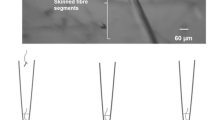Synopsis
Serial transverse sections of porcine longissimus dorsi muscle (18 pigs, 50 to 178 kg live weight) were reacted for NAD tetrazolium reductase and ATPase at pH9.4, and for glycogen with the periodic acid-Schiff (PAS) reaction. Three histochemical types of muscle fibre were identified; (1) strong ATPase and weak NADH oxidative activity; (2) strong ATPase and intermediate NADH oxidative activity; and (3) weak ATPase and strong NADH oxidative activity. Immediatepost mortem samples from one side of each animal were compared with a laterpost mortem sample from the other side by measuring the absorbance of PAS-stained glycogen at 570 nm with a microscope photometer. Laterpost mortem absorbance was expressed as a percentage of immediatepost mortem absorbance in each category of muscle fibre in order to compensate for distributional error and different starting levels of glycogen. Muscle fibres with weak ATPase and strong NADH oxidative activity showed a progressive decrease in absorbance of PAS-stained glycogenpost mortem. In some animals, fibres with strong ATPase and intermediate or weak NADH oxidative activity showed an initialpost mortem increase in absorbance of PAS-stained glycogen which was then followed by a progressive decrease. The maximum rates of decrease in absorbance in the three fibre types did not differ to any great extent.
Similar content being viewed by others
References
Bendall, J. R. (1973).Postmortem changes in muscle. In:The Structure and Function of Muscle (ed. G. H. Bourne). New York: Academic Press.
Bendall, J. R. (1975). Cold-contracture and ATP-turnover in red and white musculature of the pig,post mortem.J. Sci. Fd. Agric. 26, 55–71.
Carafoli, E. (1974). Mitochondrial uptake of calcium ions and the regulation of cell function. In:Calcium and Cell Regulation (ed. R. M. S. Smellie). Biochemical Society Symposium No. 39. London: The Biochemical Society.
Dutson, T. R., Pearson, A. M., Merkel, R. A. &Spink, G. C. (1974). Ultrastructuralpostmortem changes in normal and low quality porcine muscle fibresJ. Fd. Sci. 39, 32–37.
Engel, W. K. &Brooke, M. H. (1966). Muscle biopsy as a clinical diagnostic aid. In:Neurological Diagnostic Techniques (ed. W. S. Fields). Springfield, Illinois: Charles C. Thomas.
Greaser, M. L., Cassens, R. G., Hoekstra, W. G. &Briskey, E. J. (1969). Purification and ultrastructural properties of the calcium accumulating membranes in isolated sarcoplasmic reticulum preparations from skeletal muscle.J. Cell Physiol. 74, 37–50.
Gross, S. R. &Mayer, S. E. (1974). Regulation of phosphorylaseb toa conversion in muscle.Life Sci. 14, 401–14.
Guth, L. &Samaha, F. J. (1970). Procedure for the histochemical demonstration of actomyosin ATPase.Expl. Neurol. 28, 365–367.
Hale, L. J. (1965).Biological Laboratory Data. London: Chapman & Hall.
Kastenschmidt, L. L., Hoekstra, W. G. &Briskey, E. J. (1968). Glycolytic intermediates and co-factors in ‘fast-’ and ‘slow-glycolyzing’ muscles of the pig.J. Fd. Sci. 33, 151–8. Table 3.
Ono, K. Topel, D. G. &Althen, T. G. (1976). Cyclic AMP in longissimus muscle from control and stress susceptible pigs.J. Fd. Sci. 41, 108–10. Table 1.
Puchtler, H., Meloan, S. N. &Brewton, B. R. (1974). On the bonding of Schiff's reagent in the PAS reaction: Effects of molecular configurations in models.Histochemistry 40, 291–9.
Sayre, R. N., Briskey, E. J. &Hoekstra, W. G. (1963). Porcine muscle glycogen structure and its association with other muscle properties.Proc. Soc. exp. Biol. Med. 112, 223–5.
Swatland, H. J. (1975a). Relationships between mitochondrial content of muscle fibres and patterns of glycogen depletionpostmortem.Histochem. J. 7, 367–74.
Swatland, H. J. (1975b). Relationships between mitochondrial content and glycogen distribution in porcine muscle fibres.Histochem. J. 7, 459–69.
Swatland, H. J. (1976). Cellular patterns ofpost-mortem glycogenolysis in longissimus dorsi muscles of pigs at different live weights.Histochem. J. 8, 455–61.
Wanson, J. C. &Drochmans, P. (1972). Role of the sarcoplasmic reticulum in glycogen metabolism. Binding of phosphorylase, phosphorylase kinase, and primer complexes to the sarcovesicles of rabbit skeletal muscle.J. Cell Biol. 54, 206–24.
Weber, A. (1966). Energized calcium transport and relaxing factors.Curr. Top Bioenerg. 1, 203–54.
Author information
Authors and Affiliations
Rights and permissions
About this article
Cite this article
Swatland, H.J. Cytophotometry ofpost mortem glycogenolysis in different histochemical types of muscle fibres of the pig. Histochem J 9, 163–170 (1977). https://doi.org/10.1007/BF01003628
Received:
Revised:
Issue Date:
DOI: https://doi.org/10.1007/BF01003628




